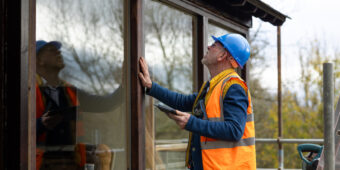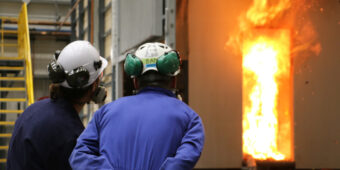Concrete slab connections
01 Apr 2021, Learn, Prove Your Know How, Technical

Proprietary wall bracing systems are commonly used to brace a building, but how are braced walls connected to a concrete slab? BRANZ provides insight to both NZS 3604:2011 and proprietary wall bracing elements requirements
Light timber-framed buildings designed to NZS 3604:2011 Timber-framed buildings require braced internal and external walls to manage the loads placed on the building through the actions of wind and seismic events.
The designer calculates the relevant loads, both along and across the building, to determine the total bracing units (BUs) required to meet these loads. They then incorporate wall bracing systems made up of wall bracing elements to meet or exceed the load requirements.
Range of types and capacities
Proprietary wall bracing systems are generally used to brace a building. They come in a range of types and are rated by their capacity to manage both wind and seismic loads, in bracing units per lineal metre (BU/m). The bracing ratings of these
proprietary systems are determined by tests based on the BRANZ P21 test methodology.
The proprietary wall bracing connections that make up these systems generally incorporate a combination of brackets or straps and mechanical fasteners to connect the bottom plate and studs of the wall assembly to the floor of the building.
NZS 3604:2011 sets requirements for connecting both internal and external wall bottom plates to concrete floors, using either cast-in anchors or proprietary post-fixed anchors. The NZS 3604:2011 requirements for placement and minimum load capacity will generally be different and of lower capacity than for anchors in proprietary wall bracing systems.
Follow manufacturer’s requirements
Connections of proprietary wall bracing elements to concrete slab floors must follow the manufacturer’s requirements. This is particularly important with post-fixed anchor connections for bottom plates of exterior bracing walls, where the as-built performance capacity of the system can be severely compromised by the incorrect selection and installation of the anchors.
Considerations with proprietary post-fixed anchors
Proprietary post-fixed anchors come in a range of types including expanding wedge or sleeve, screw and chemical set stud anchors.
Let’s look at some important considerations for proprietary post-fixed anchors in a bracing element on concrete slab floors, in
both internal and external walls.
- Minimum capacity
NZS 3604:2011 clauses 7.5.12.3, 7.5.12.4 and 8.6.1.8 set the following minimum capacity requirements for bottom plate anchors:
- In external walls:
- Horizontal loads in the plane of the wall are 2kN.
- Horizontal loads out of the plane of the wall are 3kN.
- Vertical loads in axial tension of the fastener are 7kN.
- In internal walls:
- Horizontal loads in the plane of the wall are 2kN.
- Horizontal loads out of the plane of the wall are 2kN.
- It is important that the correct type of post-fixed anchor is used – one that meets the capacity requirements in addition to the NZS 3604:2011
- Floor slab edge distance
NZS 3604:2011 clause 7.5.12.1 calls for maintaining a minimum slab edge distance of 50mm for cast-in anchors to exterior walls where the slab edge is formed with either in-situ concrete or masonry header blocks. However, it states no minimum dimension for slab edge distance of proprietary post-fixed anchors.
Manufacturers do state minimum slab edge distances for proprietary post-fixed anchors to ensure bracing capacity requirements are met, and these must be complied with. Slab edge distances are often more than 50mm.
It may not always be possible to meet these edge distance requirements with a 90 × 45mm external wall bottom plate. In these cases, 140 × 45mm framing may be required.
- Maximum centres
NZS 3604:2011 calls for proprietary post-fixed anchors to be located within 150mm of each end of a bottom plate and spaced at a maximum of 900mm centres or 600mm centres when used on slab edges formed by masonry header blocks.
Manufacturers, however, require specific location and centre spacings for their anchors to meet bracing capacity, and these must be complied with.
- Minimum embedment
NZS 3604:2011 clause 7.5.12.1 calls for a minimum embedment for cast-in anchors to exterior walls – 90mm where the slab edge is formed with in-situ concrete or 120mm when formed with masonry header blocks. It states no minimum embedment for proprietary post-fixed anchors, however.
Manufacturers set specific embedment requirements for anchors – this must be complied with and requires the correct depth and diameter hole to be drilled.
Installing proprietary anchors correctly
Careful attention is needed to install bottom plate anchors correctly. When installing anchors, ensure the:
- Required slab edge distance is achieved – it is possible to blow out the slab edge during installation if the anchor is too close.
- Correct depth and diameter hole.
- Hole is thoroughly cleaned out after drilling.
- Screw is not overtightened – torque settings generally vary from 40–80Nm.
- Required embedment depth is achieved.
Article by Greg Burn, Structure Ltd. This article was first published in Issue 182 of BRANZ Build magazine. www.buildmagazine.org.nz. Words and figures supplied by BRANZ.
Register to earn LBP Points Sign in
4 Comments
Leave a Reply
You must be logged in to post a comment.




Dstances
So close
Thanks
all good